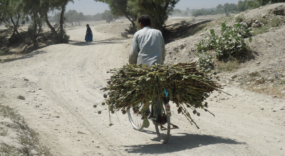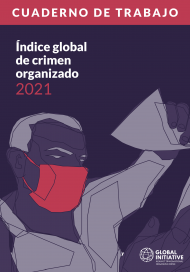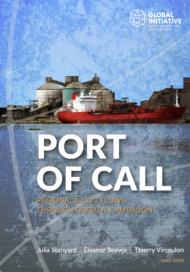Posted on 20 Feb 2023
The international community’s withdrawal of support for Afghanistan rests on the false hope that a Taliban-led state will not pose any major threat to the world. Yet the assumption that the Taliban has changed for the better is misguided. Indeed, the Taliban is now even more dangerous, interconnected with criminal actors and deeply embroiled in illicit economic activities. These threats have transnational implications.
Afghanistan, one of the countries in the world with the highest levels of criminality (7.08 out of 10) and the lowest levels of resilience to organized crime (2.67 out of 10), according to the Global Organized Crime Index, is faced with an increasingly precarious situation. Over a year into Taliban rule, breakdown of the state, bankruptcy of financial institutions, economic collapse and diplomatic isolation have pushed Afghan society to the brink of a humanitarian catastrophe. At the same time, the international community, weary from its two-decades-long struggle in the country, have washed their hands of the problem. But their hope that a Taliban-run Afghanistan will not be a threat to the world is based on three interrelated miscalculations: first, that the Taliban has changed and improved; second, that the Taliban will cut ties with foreign terrorist groups and drive them out; and third, that the Taliban has banned poppy cultivation and will prevent other organized criminal activities that have a transnational effect. Evidence from the ground suggests a different scenario. Not only has the Taliban joined forces with some 20 foreign terrorist groups, but it is deeply involved in transnational organized crime, posing clear and present dangers to the region and beyond.
The Taliban today is deeply divided, making it unable to pursue a unified course of action on any major issues. Four distinct divergences – along tribal, factional, structural and ideological lines – have turned the once fairly unitary movement into a loose conglomerate of actors, chasing frequently conflicting agendas and jockeying for positions of power within a de facto administration. Differences among the Taliban are not only ideological, but also deeply rooted in Afghan history, the country’s social structures, as well as the pragmatism of realpolitik, as the various factions within the movement compete over power and resources. One faction, the Haqqani Network, opposes the Quetta Shura faction; moderates fight the hardliners; and mid-level commanders refuse to follow orders from the leadership. Cracks are fast widening, and have already resulted in armed clashes. Moderate Taliban members, with whom the international community have interacted during talks, are far too few to exert any meaningful resistance to the movement’s alignment with foreign terrorists and transnational criminal networks.
There are more than 20 terrorist groups with a long-standing presence in Afghanistan. Most of these groups, among them al-Qaeda and several others, fought against Afghan and coalition forces for years. Since the 2021 takeover of power by the Taliban, these groups have not only maintained their presence, but have found opportunities to consolidate their forces. From this platform, they seek to breed campaigns of violence and extremism across the region and beyond. These ambitions can be seen in the multiple transborder encounters between the Taliban and Pakistani and Iranian border guards, as well as a series of rocket attacks by Islamic State Khorasan Province from Afghanistan into Tajikistan and Uzbekistan over the past few months. Most of these groups are intertwined, and enjoy cordial relations with factions within the Taliban.
Illicit economic activity, already a significant problem for Afghanistan, as documented by the Index, is simultaneously booming. Significantly affected are those markets with already high criminality scores in the Index – for example, human trafficking (which scored 8.5 out of 10) and the heroine trade (9.5). Many of the terrorist groups present, including the Taliban, are involved in these illicit economies, facilitating and carrying out large-scale organized criminal activity to finance their own operations. Criminal networks with connections around the world are engaged in the production and smuggling of drugs, including heroin, opium, methamphetamine and cannabis. In addition, non-renewable-resource crimes (such as illegal mineral extraction and smuggling, and illicit logging), as well as human trafficking and smuggling, are all considerable sources of revenue for extremist groups, including the Taliban.
Since the Taliban’s takeover, almost all criminal activities in Afghanistan have been on the rise. This is connected to the Taliban’s financial problems, the sanctions against them, as well as the overall near collapse of the country’s licit economy. Of specific concern considering Afghanistan’s economic and political climate are terrorist attacks (including coordinated attacks and attacks by lone actors), the spread of violent extremism, drug flows and large-scale human smuggling.
The Taliban’s ‘victory’ over America, NATO and the Afghan Republic has already given an ideological boost to violent extremist Islamist groups and individuals around the world, signifying the possibility that Islamic radicalism can prevail. The prevalence of regional and global terrorist groups alongside the Taliban in Afghanistan could continue to generate and inspire violent extremism in Central Asia, among the Chinese Muslim population, and within marginalized Muslim populations in Europe and North America. Such ideological predisposition could potentially translate into forms of terrorism.
Also likely to increase under the Taliban are drug flows from Afghanistan into Pakistan, Iran, Central Asia, China, Russia, Turkey, Europe, and East and southern Africa, given the boost in supply in Afghanistan. This includes heroin, opium, methamphetamine and cannabis. Other illicit activities, including illegal mining and logging, as well as human smuggling and trafficking, seem to be on the rise, leading to an outflow of gemstones, semi-precious minerals, timber and fauna (and related animal products). Wealthy consumer markets, such as the Gulf states, Europe and North America, are likely to be the primary destinations for most of these commodities. The adverse impacts on Europe and North America could range from health and security issues to crime and instability, including potential human and animal rights abuses.
A less immediate threat is the large number of Afghan refugees in Pakistan and Iran, who, having faced poverty, suffering and human rights violations for years, are potentially major recruitment sources for radical and terrorist groups. An increase in the number of refugees seeking to escape Taliban rule would exacerbate these problems. In Europe, the issue of foreign immigrants is a sensitive and divisive debate, and the flood of new Afghans seeking refuge will continue to be a significant topic of political contention.
The Taliban rule in Afghanistan has both direct and indirect consequences for security in an already fragile region, accompanied as it has been by increases in criminal markets with very high Index scores, including violent extremism, drug smuggling and human trafficking. In particular, the symbiotic relationship between the Taliban, foreign terrorist groups and transnational organized criminal networks means that a Taliban-led state poses significant threats to the security of the region and beyond.
This analysis is part of the GI-TOC’s series of articles delving into the results of the Global Organized Crime Index 2021. The series explores the Index’s findings and their effects on policymaking, anti-organized crime measures and analyses from a thematic or regional perspective.



